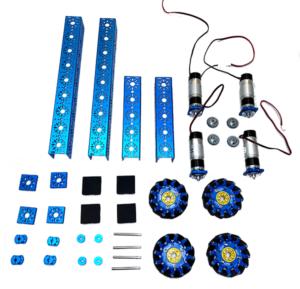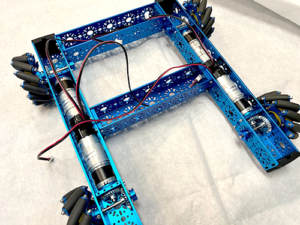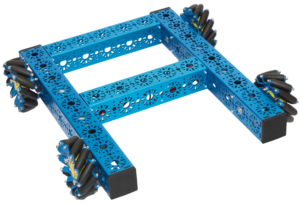Why Choose a Robot Chassis with Mecanum Wheels?
Should you use an Omni-wheel or Mecanum chassis for your next robotics competition? This article will help you decide.

You may have noticed that many mobile robotics competitions have moved from an Omni-wheel chassis to a mecanum chassis. Why the change? How does the type of robot wheels used in your chassis affect your robot when you are competing? In this article, we will explore the differences and discuss the advantages of using Mecanum wheels instead of Omni Wheels. We will also showcase a complete solution for creating your Mecanum drivebase. This robust robotics kit, the FTC Drive Base Kit - v2, includes all the elements needed to build a Mecanum drive train.
Why Build a Mecanum Chassis?
For one, building a Mecanum drivebase is an excellent addition to STEM education. It offers an opportunity for students to learn a variety of STEM concepts. Compared to an Omni wheel chassis building a Mecanum drive train requires a lot of programming. Mecanum wheels must be properly oriented. The angle of the rollers is an integral part of the code for the mecanum drivetrain, while this is not the case for an Omni-wheel drivetrain. This requires a decent level of mathematics such as calculus and trigonometry making it fit perfectly with STEM education goals. For example, the calculus of the programming algorithm helps students understand how the angle of each roller affects the direction the robot travels. A variety of mechanical and software concepts and skills can be learned in a project like this. Since the wheels must be individually powered and programmed, the overall design of the robot must be perfectly balanced if you want your robot to drive properly. But logistically, what are the benefits as compared to a drivebase with Omni wheels? Let's take a closer look.
Should you Use a Mecanum or Omni Drivetrain?
For the context of this article, we are speaking in the context of a simple square drivebase. Given that, let's consider the scenarios where it would be best for your robot to use a drivetrain with Mecanum wheels instead of Omni wheels.
Five Things to Consider When Deciding What Wheels to Use for your Chassis:
#1 - Traction: Both options will offer solid traction.
#2 - Dynamic Movement: Omni wheels enhance rotation making it easier to turn left or right more efficiently. Mecanum wheels offer enhanced mobility in all directions which is particularly useful for achieving side-to-side strafing movement. (Yes, Omni wheels could be used to create strafing movements, but not in the context of a simple square drivebase. This would require X-Drive and Holonomic drive base builds.)
# 3 - The Robot Competition Game: Your decision will be based on what challenges your robot will need to overcome during the competition.
-
- For example, in the FIRST ® Tech Challenge 2021-2022 FREIGHT FRENZYSM presented by Raytheon Technologies, there were speedbumps on the playing field. For this reason. Omni wheels were ideal because Mecanum wheels could not drive over them.
- This year, in the FIRST ® Tech Challenge 2023-2024 CENTERSTAGESM presented by RTX, there are no speedbumps that could impact your robot's mobility. However, there are rungs in the center of the robot competition field that create relatively small spaces for a robot to pass through. Using a drive base using Mecanum wheels, these can be traversed in a multitude of ways without the need for a traditional turn. For example, you can drive forward and then strafe from side to side to drive through these spaces.
#4 - Number of Wheels: Mecanum wheels require a motor for each wheel. Therefore, they can only be used for a 4-wheel drive base. If your answer is 2 or 3 wheels, you will need to use Omni wheels.
#5 - Number of Motors: Again, the Mecanum wheels require one motor per wheel. With Omni wheels, you could use two motors to power a 4-wheel drive robot.
Everything You Need to Build a Mecanum Drivebase

The FTC Drive Base Kit - v2 from Studica Robotics is the perfect solution for your next drivetrain. This complete robot drive base kit includes all the materials needed to create a robust Mecanum chassis. This complete drivetrain competition robot kit includes a wide variety of components including 4 - NeveRest Orbital 20 Gearmotors with encoder cables, new clamping shaft hubs, 4 bumpers, and complete hardware to complete the mecanum chassis. View the complete list of components. Studica Robotics also provides STEP 3D files for each part allowing you to easily design your robot in Solidworks, Inventor, Fusion 360, or Creo. The Mecanum wheels and NeveRest Orbital 20:1 gear motors create a very maneuverable and swift chassis.
Why Choose the Mecanum Chassis Kit from Studica Robotics?
Studica Robotics is a comprehensive robotics building platform that provides everything you need to build, learn, and compete. We offer various robot parts, robotics kits, and cutting-edge electronics. This powerful robotics platform is ideal for the classroom, robotics teams, homeschoolers, hobbyists, enthusiasts, and anyone who wants to make their build ideas come to life.

Advantages of the FTC Drive Base Kit - v2:
- Our innovative slim 100mm Mecanum wheels have bearings on all rollers.
- Our channel components are thick, strong, and durable.
- The motors recess into our U-Channel components allowing for better space and wiring management.
- This distributes the weight more evenly and reduces the gear system's strain on the motor.
- This drivebase is low to the ground giving robots the ability to avoid obstacles that will be on the field. The speed and maneuverability of the chassis created using the FTC Drive Base Kit - v2 allows for fast and agile traversal of a robot competition playing field.
- Building this drive base is an excellent exercise to get your robotics team competition-ready. Once built, everyone can start focusing on building the mechanisms needed to compete.
- Additional robot parts needed to power your robot including sensors and robot controllers are available from Studica Robotics.
With a reputation for technical expertise, Studica Robotics is an innovator committed to supporting the needs of the education and robotics competition communities. Our durable, affordable structure components are easy to assemble and connect to our wide range of motion components. Our electronics, from controllers to sensors, empower your robot with cutting-edge capabilities. Our VMX Robotics Controller is versatile and programmable in multiple languages, making it ideal for complex projects and autonomous robots. Discover your true building potential with Studica Robotics!


